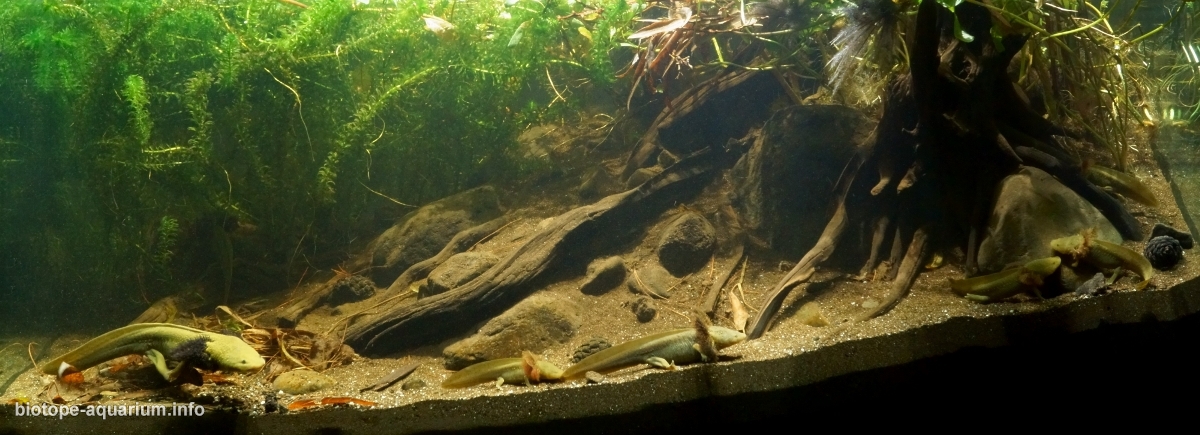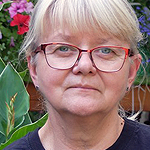Habitat Ambystoma dumerilii, Pátzcuaro Lake riverside, Urandén, México
10th place in Biotope Aquarium Design Contest 2019
Mexico. José Ramiro Linares Buenrostro

Volume: 324 L
Dimensions: 120 X 60 X 45 cm.
List of fishes: Ambystoma dumerilii (endemic), Physa sp., and Cambarellus patzcuarensis (endemic, It is used as food).
List of plants: Sagittaria macrophylla (endemic), Hydrocotyle ranunculoides, Egeria densa, Nymphaea mexicana, Ludwigia peploides, Leersia hexandra, Eichhornia crassipes, Berula erecta and Lemna sp..
Description of decorations: Through rocks with rounded edges, natural substrate mix of sand and mud, leaves, seeds, some fallen branches (all this extracted from the habitat of areas where the environment impact was minimal) and driftwood that look very similar to that found in the biotope; the recreation of the riverside of the lake was realized, was performed based on where some tree roots grow.
Description of equipment: Basket filter BOYU EF45, with flow capacity of 1100 liters / hour although it is regulated to 350 liters / hour approximately, it uses 3 different thicknesses of sponge as Azoo mechanical filter and 2 liters of Matrix Seachem brand for the filter biological. The lighting consists of 3 IUSA brand reflectors of 4500 lumens each at a temperature of 6500° K. No equipment is used to regulate the temperature.
Water parameters: The parameters were measured by PRO JBL Scan, Nitrate (NO3): 10 mg / l, Nitrite (N02): 0 mg / l, Total hardness (GH):> 4 d °, Carbonate hardness (KH): 15 d ° , PH: 7.6 and water the temperature ranges between 18° and 21°C.
Additional info: Cambarellus patzcuarensis is used as food, but due to the disposition of the biotope aquarium assembly, it has adapted and even increased in number. Because the feeding of A. dumerilii is done through a diet of live foods (Cambarellus patzcuarensis, Dafnia sp., Eisenia foetida, Tbifex sp. And Lumbriculus variegatus), partial changes of 33% are made every 15 days.
INFORMATION ABOUT BIOTOPE
Description of the area surrounding the biotope: Pátzcuaro lake has a surface area of 260 km2 of which 111 km2 belong to the mirror of the lake covering 4 regions: Erongarícuaro, Quiroga, Pátzcuaro and Tzintzuntzan all of them belonging to the state of Michoacán, Mexico, with a length of 55 km and width of 34 km, the lake basin provides a humid temperate climate with rains in summer; the average annual temperature is 14-20 ° C, has an average depth of 5 m being its deepest part of 8m. At coordinates 19 ° 32’27.3 “N 101 ° 38’25.1” W is the Uranden pier which meets a crystalline water reservoir surrounded by several Quercus rugosa and Quercus alguns. Most of the soil is used for cultivation of vegetables and the raising of cattle, a few meters from the pier there are some houses and buildings of the inhabitants, on the shore of the lake you can see several wooden boats that the locals use for transportation to the island where most them live.
Description of the underwater landscape of the biotope: The bottom in general is a mixture of clay and very fine sand, rocks of different shapes, sizes and porosities, you can also see parts of pine seeds and decaying leaves, as well as branches that have fallen to the bottom, the lake’s riverside does not have steep slopes, with a máximum depth that does not exceed 1.5 meters, in some places you can see the roots of the trees that grow on the shore as well as some marshy plants.
Description of the parameters of the habitat: The parameters were measured by PRO JBL Scan, Nitrate (NO3): 10 mg / l, Nitrite (N02): .25 mg / l, Total hardness (GH):> 4 d °, Carbonate hardness (KH): 20 d ° , PH: 7.8 and the water temperature ranges between 18° and 23°C.
List of fishes and invertebrates occurring in the nature biotope: Cambarellus patzcuarensis, Allophorus robustus, Skiffia lermae, Allotoca vivípara, Goodea atripinnis, Chirostoma grandocule, Chirostoma patzcuaro, Chirostoma bartoni, Chirostoma estor, Algansea lacustris, Ctenopharingodon idellus, Cyprinus specularis, Tilapia melanopleura, Micropterus salmoides, Physa sp. and Ambystoma dumerilii.
List of plants found in the nature biotope: Sagittaria macrophylla (endemic), Hydrocotyle ranunculoides, Egeria densa, Nymphaea mexicana, Ludwigia peploides, Leersia hexandra, Eichhornia crassipes and Berula erecta, Lemna sp, Typha domingensis, Schoenoplectus californicus and Arundo donax.
Threats to the ecology: The lake of Pátzcuaro and its surroundings present a number of spaces with tourist attractions, since it is here where much of what remains of the Purépecha culture is housed, for many years the resources it offers have been exploited in an uncontrolled way, including its surroundings, causing the lake’s health to strongly deteriorate; the uncontrolled contribution of organic matter, the introduction of exotic plants such as Eichhornia crassipes which is a plant that can completely cover the surface of the water and prevent the exchange of gases and the passage of the Sun, the introduccion of at least five species of exotic fish, pollution through solid waste such as plastics, tires, glass that reach the lake through the sewage system, the population growth and the increase in human activities such as agriculture, cattle raising and non-responsible tourism are some of the reasons why the lake is in decline and, although there have been strong national and foreign investments to help rescue the lake, little has been solved. In spite of all these factors against Ambystoma Dumerilii (Achoque), it has persisted, although some researchers had considered it extinct in their natural habitat, in the present year they have found a population of at least 15 specimens, although the inhabitants of the lake shore mention that it has never been extinguished but instead its population has drastically declined. Given the conditions in which this species is found, this biotope aquarium was made in order to publicize this species, so particular and endemic to the world.
Sources of information:
Juan Pablo Ramírez Herrejón and Omar Domínguez. (s.f.). EL LAGO DE PÁTZCUARO, UN LAGO EN DECADENCIA. Retrieved July 30, 2019, from https://www.sabermas.umich.mx/
62. PÁTZCUARO Y CUENCAS ENDORRÉICAS CERCANAS. (s.f.). Retrieved July 30, 2019, from http://www.conabio.gob.mx/
HUACUZ ELÍAS, D. (2012). MANUAL PARA EL MANEJO EX SITU DE ACHOQUES. 1st ed. [ebook] Morelia, Michoacán,. Available at: https://drive.google.com/open?
González Jassí, H., Castelán Ortiz, H., Servín Zamora, E., Barrera Manzano., H., Leal Nieves, J., Serrano Campos, M. and Monroy Jacobo, H. (2017). MANNUAL DE MANEJO BAJO CUIDADO HUMANO ACHOQUE (AMBYSTOMA DUMERILII). 1st ed. [ebook] CALIMAYA, ESTADO DE MEXICO. Available at: https://drive.google.com/open?
González Jassí, H., Castelán Ortiz, H., Servín Zamora, E., Barrera Manzano., H., Leal Nieves, J., Serrano Campos, M. and Monroy Jacobo, H. (2017). MANNUAL DE MANEJO BAJO CUIDADO HUMANO ACHOQUE (AMBYSTOMA DUMERILII). 1st ed. [ebook] CALIMAYA, ESTADO DE MEXICO. Available at: https://drive.google.com/open?
Comments of the members of the jury of Biotope Aquarium Design Contest 2019

Apologies to the hosts, I know too little of these organisms to feel confident speaking as an authority on this tank.

All enthusiasts this animal should see this aquarium. We usually watch candy aquariums with these amphibians. Here their natural habitat life was shown. A great movie, great light. Thank you to the author for showing the natural environment of these interesting animals.

Very fine setting with making the slope of the ground and the arrangement of the wood.

It is a great work well accomplished with few materials, showing how the habitat of these Pátzcuaro axolotles is observed in nature, which I have been able to see. The arrangement of the slope with the roots simulates very well the entrance of the driftwood to the water that could be found on the banks of the lake. Congratulations, well done!

This is easily one of my favorite biotopes. Care has been taken here to replicate the natural habitat of these unusual and threatened axolotols, and their calm behavior reflects this. Roots have been scaped into the substrate in a very organic way, as though grown into the dark sand and stones. The mix of fallen leaves and pine needles is a nice touch. The plant life accurately reflects the real biotope. In fact the overall impression closely matches the footage of the genuine habitat in all aspects, including the water clarity and bright light. It is a testament to the viability of this system that the crayfish included as prey were also able to establish themselves and reproduce!

I was really intrigued by these beauties. I liked the simple, inspiring setup with the root system, a very natural use of soil materials and a lot of plants. Only minus: I would like to see these beauties in a bigger tank. Thanks for sharing this interesting description with us! Keep biotoping!
